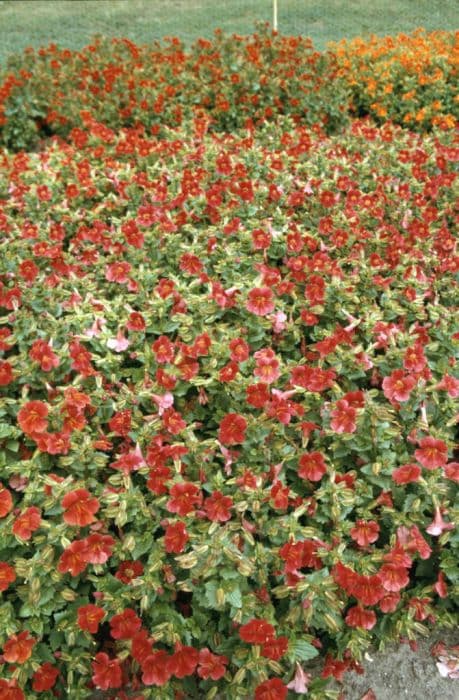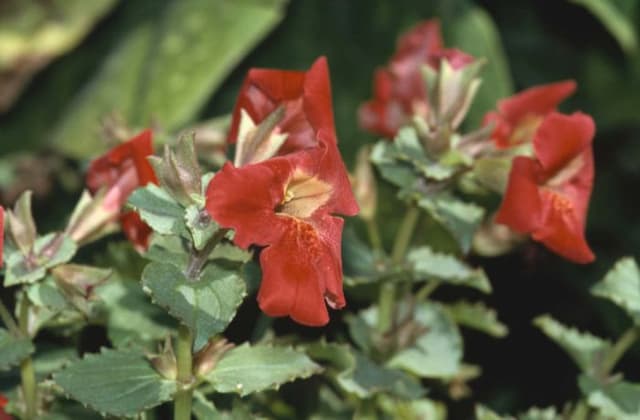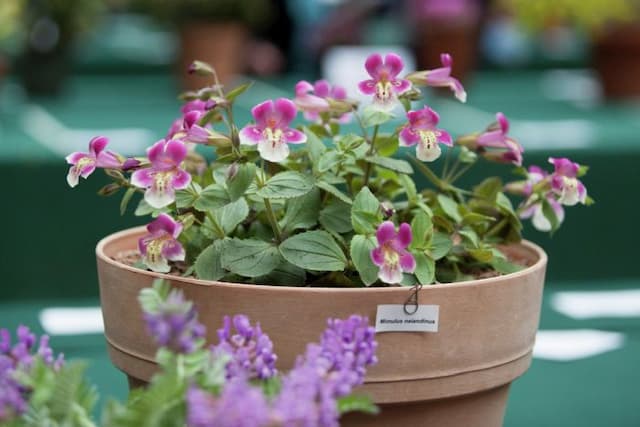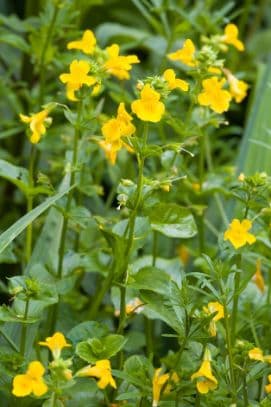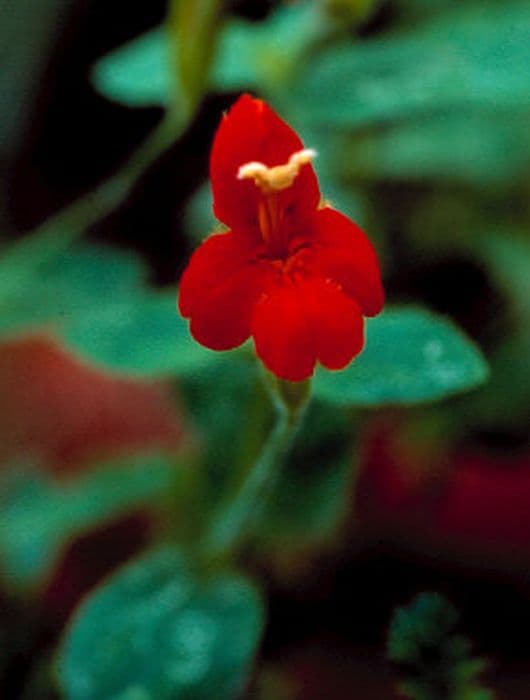Monkey flower Mimulus ringens





ABOUT
Commonly known as the square-stemmed monkey flower, this plant boasts a distinctive square-shaped stem which gives it its common name. The leaves of this plant are opposite, meaning they grow in pairs on opposite sides of the stem, with an elongated shape tapering to a point. These leaves are usually a rich green. The flowers are the most striking feature, with a tubular structure opening into a two-lipped formation, resembling a face, which is characteristic of the monkey flower. They are typically a purple or lavender color, providing a vivid contrast against the foliage. Often, the flowers will have patterns or spots in a deeper shade that adds to their ornamental value. These blossoms are a magnet for bees, butterflies, and other pollinators, making the square-stemmed monkey flower not only a delight for the eyes but also an important part of the local ecosystem. As a herbaceous perennial, it has a seasonal life cycle, dying back in the colder months and re-emerging from its root system with the return of warmer weather.
About this plant
 Names
NamesFamily
Phrymaceae.
Synonyms
Allegheny Monkeyflower, Square-stemmed Monkeyflower, Lavender Monkeyflower, Monkeyflower.
Common names
Eunanus ringens, Mimulus alatus var. ringens, Mimulus ringens var. colpophilus.
 Toxicity
ToxicityTo humans
The plant commonly known as Monkey Flower (Mimulus ringens) is not widely recognized for its toxicity to humans. There is limited information available regarding the ingestion of any parts of this plant, and it is not typically listed among plants that are poisonous to people. However, as with any plant, individual allergies and sensitivities may exist, and it is always advised to avoid eating or handling plants unless you are certain of their safety. If ingestion or significant contact with the Monkey Flower occurs and adverse effects are noted, it is recommended to seek medical advice.
To pets
For Monkey Flower (Mimulus ringens), there is no significant evidence to suggest that this plant is highly toxic to pets. However, the absence of widespread knowledge regarding its effects on animals should be noted, and owners should generally exercise caution to prevent pets from ingesting plants not meant for consumption. If a pet does ingest Monkey Flower and exhibits symptoms such as gastrointestinal upset, or any other unusual behavior, it is advised to consult with a veterinarian.
 Characteristics
CharacteristicsLife cycle
Perennials
Foliage type
Deciduous
Color of leaves
Green
Flower color
Lavender
Height
2 feet (0.61 meters)
Spread
2 feet (0.61 meters)
Plant type
Herb
Hardiness zones
3-8
Native area
North America
Benefits
 General Benefits
General Benefits- Attracts Pollinators: Mimulus ringens, also known as Monkeyflower, is known to attract bees, butterflies, and other pollinating insects, which is beneficial for the pollination of nearby plants.
- Wildlife Habitat: It provides cover and breeding sites for small aquatic wildlife and insects, supporting biodiversity in an ecosystem.
- Erosion Control: The root system of Monkeyflower stabilizes soil, reducing erosion along riverbanks and wetland areas.
- Water Quality: By establishing itself along water margins, it can help to filter runoff and improve the water quality of the surrounding aquatic habitats.
- Aesthetic Appeal: With its attractive purple flowers, Monkeyflower adds visual interest and natural beauty to gardens and natural landscaping.
- Native Species Support: As a native plant to North America, it plays a role in supporting local ecosystems and maintaining native plant communities.
- Adaptability: Mimulus ringens is adaptable to a variety of wetland habitats, making it a versatile choice for restoration and conservation projects.
- Low Maintenance: Once established, it generally requires minimal care, making it favorable for gardeners and ecological designers looking for sustainable planting options.
 Medical Properties
Medical Properties- Anti-inflammatory: Mimulus ringens has been traditionally used to reduce inflammation in various parts of the body.
- Diuretic: The plant has diuretic properties and has been used to promote the production of urine, helping in the flushing of the urinary tract.
- Sedative: There are anecdotal reports suggesting its use as a mild sedative to alleviate anxiety and promote relaxation.
- Antispasmodic: It is said to possess antispasmodic properties, potentially relieving muscle spasms and cramps.
 Air-purifying Qualities
Air-purifying QualitiesThis plant is not specifically known for air purifying qualities.
 Other Uses
Other Uses- Mimulus ringens, commonly known as Monkey Flower, can be used as a natural dye for fabrics, providing a range of colors depending on the mordant used.
- The plant may be employed in educational settings as a model organism for botanical studies due to its distinctive flowers and pollination mechanism.
- Mimulus ringens can be grown in rain gardens to take advantage of its preference for moist conditions and to aid in water filtration and runoff reduction.
- Monkey Flower can serve as a tool for teaching about native plant conservation and restoration ecology in its natural habitat.
- The flowers may be used in the art of pressed plant crafts, as their striking appearance maintains some vibrancy even when dried.
- This plant contributes to stabilization of stream banks, thanks to its root system that holds soil in place and reduces erosion.
- It can provide an ornamental option for constructed wetlands or natural water features in landscaping designs that seek to incorporate native species.
- Monkey Flower can be utilized in citizen science projects for phenology studies, which track the timing of biological events like flowering and seed setting.
- The plant can act as a living laboratory for ecological studies on plant-pollinator interactions, specifically how bees and other insects contribute to its pollination.
- Mimulus ringens can be incorporated into sensory gardens for educational purposes to help individuals learn about textures, scents, and colors in nature.
Interesting Facts
 Feng Shui
Feng ShuiThe plant known as Monkey Flower is not used in Feng Shui practice.
 Zodiac Sign Compitability
Zodiac Sign CompitabilityThe Monkey Flower is not used in astrology practice.
 Plant Symbolism
Plant Symbolism- Overcoming Fear: Mimulus ringens, commonly known as Monkey Flower, symbolizes overcoming fear as the flower is associated with the essence used in Bach flower remedies for this purpose.
- Courage: The Monkey Flower also represents courage, encouraging individuals to face challenges and fears with bravery.
- Psychic Protection: Some believe that Monkey Flower can offer psychic protection, helping to shield one's emotions from negative energies.
- Emotional Sensitivity: It is linked with emotional sensitivity, offering comfort to those who are very empathetic and easily affected by their surroundings.
- Joyfulness: The bright and cheerful appearance of the Monkey Flower suggests an association with joy and positive energy, bringing lightness to one's spirit.
 Water
WaterMonkey Flower needs consistent moisture and should be watered regularly to keep the soil evenly damp but not waterlogged. They are often found naturally in wet environments, so mimic these conditions by watering deeply at least once a week with about 1-2 gallons of water per plant, depending on the environmental conditions and soil drainage.
 Light
LightMonkey Flower thrives in partial shade but can tolerate full sun in cooler climates. The best spot for this plant is one where it can receive morning sunlight and afternoon shade, or dappled sunlight throughout the day, to protect it from the intense heat of midday sun.
 Temperature
TemperatureMonkey Flower prefers moderate temperatures and can survive in a range between 60 to 85 degrees Fahrenheit. Frost can damage the plant, so the minimum temperature should not drop below 32 degrees Fahrenheit. Ideal growing conditions are in areas that generally maintain a temperature within the preferred range.
 Pruning
PruningPruning Monkey Flower is mainly to remove spent flowers and encourage bushier growth. Deadhead regularly during the blooming season to promote continuous flowering. Cut back the plant after flowering to maintain shape and health, typically doing so in late fall or early spring.
 Cleaning
CleaningAs needed
 Soil
SoilThe best soil mix for Monkey Flower (Mimulus ringens) is a well-draining, moist organic soil. A mix of loamy soil with added compost or peat is ideal, as the plant thrives in wet environments. The soil pH should be slightly acidic to neutral, ranging from 5.8 to 7.0.
 Repotting
RepottingMonkey Flower does not frequently require repotting as it's often grown as an annual or it spreads naturally in the wild. However, if grown as a perennial, repotting every 2 to 3 years in the spring is sufficient to replenish soil nutrients.
 Humidity & Misting
Humidity & MistingMonkey Flower prefers a high humidity environment that mimics its natural wetland habitat. Although it does not require tropical levels of humidity, consistently moist air supports its growth and flowering.
 Suitable locations
Suitable locationsIndoor
Ensure bright indirect light, high humidity, and moist soil for indoor Monkey Flower.
Outdoor
Plant in partial shade, maintain moist soil, and protect from strong winds for outdoor Monkey Flower.
Hardiness zone
3-8 USDA
 Life cycle
Life cycleMimulus ringens, commonly known as Allegheny monkeyflower, begins its life as a seed, usually germinating in spring when conditions are moist and cool. Seedlings establish themselves and develop into vegetative plants with square stems and opposite leaves. The plant enters a phase of rapid growth during late spring to early summer, preparing for reproductive maturity. Flowering typically occurs in mid to late summer, displaying blue to purple two-lipped flowers that are primarily pollinated by bees. After pollination, the plant produces fruit in the form of capsules containing numerous tiny seeds. As the growing season concludes, the Allegheny monkeyflower completes its life cycle by dropping seeds into the surrounding environment before dying back, with the seeds lying dormant until the next favorable germination period.
 Propogation
PropogationPropogation time
Spring-Early Summer
Mimulus ringens, commonly known as Monkey Flower or Square-stemmed Monkey Flower, can be propagated by seed, which is the most popular method. Seeds should be sown in late fall to early winter directly into a seedbed or in pots. They require light for germination, so it is best to simply press them onto the soil surface rather than covering them with soil. They should be kept moist but not waterlogged. As cold temperatures can help to break the seed's dormancy, the seed tray can be left outside over winter to experience the natural fluctuations in temperature. Seedlings will appear the following spring, at which point they can be thinned out or transplanted to their final growing positions once the risk of frost has passed and they have developed strong root systems.
